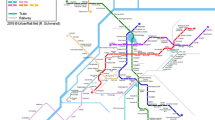Abstract
This paper studies the route choice behavior of passengers from auto fare collection and timetable data using a method combined with Bayesian and Metropolis–Hasting sampling. First, influential factors of route choice such as in-vehicle travel time, transfer time, and in-vehicle crowding are selected. Then, formulations of these factors are established for a single passenger, which are merged into a logit model to model route choice behavior of subway passengers. Next, an algorithm that integrates Bayesian inference and Metropolis–Hasting sampling is designed to calibrate the parameters of the logit model. Finally, a case study of Bei**g subway is applied to verify the validity of the developed model and algorithm.
Access this chapter
Tax calculation will be finalised at checkout
Purchases are for personal use only
Similar content being viewed by others
References
Eboli L, Mazzulla G (2008) A stated preference experiment for measuring service quality in public transport. Transportation Planning and Technology 31(5):509–523
Xu X, Liu J, Li H et al (2016) Capacity-oriented passenger flow control under uncertain demand: algorithm development and real-world case study. Transp Res Part E Logistics Transp Rev 87:130–148
Li Z, Hensher DA (2011) Crowding and public transport: a review of willingness to pay evidence and its relevance in project appraisal. Transp Policy 18(6):880–887
Prud’homme R, Koning M, Lenormand L et al (2012) Public transport congestion costs: the case of the Paris subway. Transp Policy 21:101–109
Sun L, Lu Y, ** JG et al (2015) An integrated Bayesian approach for passenger flow assignment in metro networks. Transp Res Part C Emerg Technol 52:116–131
Sadhukhan S, Banerjee UK, Maitra B (2014) Commuters’ perception towards transfer facility attributes in and around metro stations: experience in Kolkata. J Urban Plan Develop 141(4):04014038
Chen T, Mao B, Gao L et al (2007) Research about passenger travel choice behavior of dedicated passenger railway line. J China Railway Soc 3:001
Kim KM, Hong SP, Ko SJ et al (2015) Does crowding affect the path choice of metro passengers? Transp Res Part A Policy Pract 77:292–304
Jara-Díaz S, Gschwender A (2003) Towards a general microeconomic model for the operation of public transport. Transp Rev 23(4):453–469
Raveau S, Guo Z, Muñoz JC, Wilson NH (2014) A behavioural comparison of route choice on metro networks: time, transfers, crowding, topology and socio-demographics. Transp Res Part A Policy Pract 66:185–195
Tirachini A, Hensher DA, Rose JM (2013) Crowding in public transport systems: effects on users, operation and implications for the estimation of demand. Transp Res Part A Policy Pract 53:36–52
Sun S, Li H, Xu X (2017) A key station identification method for urban rail transit: a case study of Bei**g subway. Promet-Traf Transp 29(3):267–273
Acknowledgments
This work is financially supported by the National Natural Science Foundation of China (No. 71601018, 61403288), and the Bei**g Natural Science Foundation (No. 9164033).




